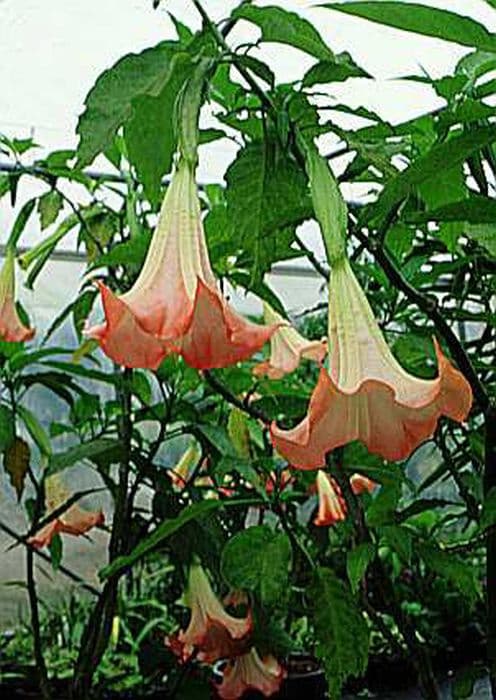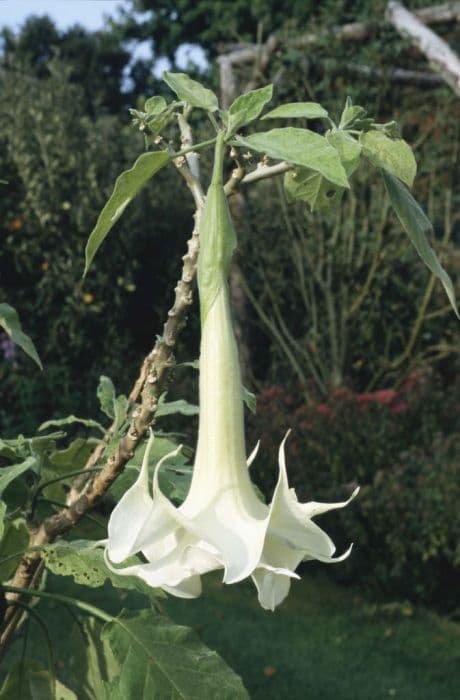Petunia Petunia Designer Buzz Purple = 'Kerbuzzby' (Designer Series)

ABOUT
The Petunia Designer Buzz Purple, also known by its cultivar name 'Kerbuzzby', is a striking plant renowned for its showy flowers. These vibrant blooms exhibit a rich purple hue, blending into a slightly darker center which often appears nearly black, creating a dramatic contrast. The flowers of the 'Kerbuzzby' are characterized by their funnel-like shape with edges that can be slightly ruffled, adding to their ornamental appeal. Each bloom features five lobes that flare outward, sometimes displaying delicate veining that accentuates their color. The juxtaposition of the deep purple against the green foliage makes for an eye-catching display. The leaves of the Petunia Designer Buzz Purple are smooth with a slightly sticky texture, typical of many petunias. They are medium to dark green in color, providing a lush backdrop for the stunning flowers. The foliage is also dense, creating a full and vibrant plant body. Overall, the 'Kerbuzzby' presents a luxurious and colorful addition to any garden or container, captivating onlookers with its bold floral display.
About this plant
 Names
NamesFamily
Solanaceae
Synonyms
Petunia Designer Buzz Purple, 'Kerbuzzby' Petunia
Common names
Petunia × hybrida 'Kerbuzzby'
 Toxicity
ToxicityTo humans
Petunias, including the Designer Buzz Purple variety, are not considered toxic to humans. They do not contain substances known to cause serious poisoning or adverse reactions when ingested. However, eating any non-food plant can potentially cause mild stomach upset or an allergic reaction in sensitive individuals.
To pets
Petunias are generally considered non-toxic to pets. The Designer Buzz Purple, like other petunias, does not contain known toxins that are harmful to pets if ingested. While they are not poisonous, ingestion of plant material could potentially cause mild gastrointestinal upset such as vomiting or diarrhea in some pets, particularly if ingested in large quantities.
 Characteristics
CharacteristicsLife cycle
Annuals
Foliage type
Deciduous
Color of leaves
Green
Flower color
Purple
Height
1 feet (30 cm)
Spread
1 feet (30 cm)
Plant type
Herb
Hardiness zones
9
Native area
South America
Benefits
 General Benefits
General Benefits- Attracts Pollinators: Petunias are known to draw bees and butterflies to a garden, aiding in the pollination of various plants.
- Easy to Grow: Petunias are relatively low-maintenance, making them suitable for novice gardeners.
- Long Blooming Period: They typically bloom from spring until the first frost, providing long-lasting color to the garden.
- Versatility: Petunias can be planted in flowerbeds, containers, and hanging baskets, offering flexibility in garden design.
- Drought Tolerant: Once established, petunias can tolerate brief periods of drought, reducing the need for constant watering.
- Colorful Display: The 'Designer Buzz Purple' variety offers vibrant purple hues that can enhance the visual appeal of any garden space.
- Compact Growth: This cultivar generally has a tidy growth habit, which can help maintain a neat and structured garden appearance.
 Medical Properties
Medical PropertiesThis plant is not used for medical purposes.
 Air-purifying Qualities
Air-purifying QualitiesThis plant is not specifically known for air purifying qualities.
 Other Uses
Other Uses- Petunia-infused ink: The vibrant petals of petunias can be crushed to create a natural dye which can be used in bespoke ink formulations for art and calligraphy.
- Fabric dye: Similar to ink, the petals of the petunia can be used to dye fabrics with shades of purple and add unique, natural patterns to textiles.
- Edible decoration: Although not widely known for their taste, petunia flowers are edible and can be used as a garnish for salads and desserts to add a pop of color.
- Natural confetti: Dried petals of the petunia can be tossed as biodegradable confetti for celebrations like weddings or garden parties.
- Photography subjects: Petunias, especially those with vibrant colors like 'Designer Buzz Purple', make excellent photography subjects for botanical portfolios or as art prints.
- Scrapbooking and crafts: Pressed petunia flowers can be used in scrapbooking, card-making, and other paper crafts, adding a touch of nature to creative projects.
- Culinary experiments: Some adventurous chefs might use petunia flowers to infuse syrups or sugars, though their taste profile would be more for visual appeal than flavor.
- Aromatherapy sachets: While not as potent as some other flowers, dried petunia petals can be included in sachets to gently scent drawers and closets.
- Floating candle displays: Petunia flowers can float and are sometimes used in water bowls with floating candles for decorative centerpieces at events.
- Teaching tool: The genetic diversity and ease of breeding petunias make them useful in educational settings to teach about plant genetics and hybridization.
Interesting Facts
 Feng Shui
Feng ShuiThe plant Petunia is not used in Feng Shui practice.
 Zodiac Sign Compitability
Zodiac Sign CompitabilityThe plant Petunia is not used in astrology practice.
 Plant Symbolism
Plant Symbolism- Anger: In some contexts, petunias can represent anger or resentment. This symbolism might stem from the way petunias can proliferate and take over space if left unchecked.
- Resentment: Similar to anger, petunias can sometimes symbolize feelings of resentment or dissatisfaction, reflecting the emotions one might wish to convey when they are displeased with a situation.
- Desire: Petunias can also symbolize a desire or longing for someone's company, reflecting their bright, inviting flowers.
- Comfort: Their wide and vibrant blooms may offer a symbol of comfort and the soothing presence they can bring to an environment.
- Peace: With their soft and pleasant appearance, petunias can be seen as a symbol of peace and tranquility, embodying a sense of calm.
 Water
WaterPetunias should be watered thoroughly about once a week, though this may vary depending on climate conditions and whether they are in the ground or in containers. On average, give your petunias about one to one and a half gallons of water per watering session. It's important to avoid overhead watering to minimize the risk of disease. Instead, water at the base of the plant to keep moisture off the foliage. In hot weather or if the plants are in containers, you may need to water more frequently, up to every other day, ensuring the soil remains moist but not waterlogged.
 Light
LightPetunias require full sun to thrive, which means they should receive at least 6 to 8 hours of direct sunlight daily. A spot that provides morning sun with some protection from the intense afternoon heat is ideal in hot climates. However, these versatile plants can still perform well with more sun, as long as they receive adequate moisture.
 Temperature
TemperaturePetunias prefer temperatures between 60 and 85 degrees Fahrenheit but can tolerate as low as 35 degrees and as high as 90 degrees for short periods. However, prolonged exposure outside this range can stress the plants. The ideal conditions for petunias to flourish are during the warmer months of spring through fall where the nights do not dip below 39 degrees.
 Pruning
PruningPrune petunias to encourage bushier growth and more flowers. Do this by pinching off the tips of the plants every few weeks, especially when they are young. Petunias also benefit from deadheading, which involves removing faded or dead flowers to promote continued blooming. The best time for heavy pruning is midsummer when plants can become leggy or sparse.
 Cleaning
CleaningNot needed
 Soil
SoilFor Petunias, a well-draining potting mix with peat moss or coco coir, perlite, and vermiculite is ideal. The pH should be slightly acidic to neutral, around 5.5 to 7.0. Regular feeding with a balanced fertilizer is recommended.
 Repotting
RepottingPetunias do not commonly require frequent repotting. Annual repotting may be beneficial, especially to refresh the soil and remove salt build-up from fertilization.
 Humidity & Misting
Humidity & MistingPetunias prefer moderate humidity levels but are adaptable to various conditions as long as they are not in overly dry air; misting is usually not necessary.
 Suitable locations
Suitable locationsIndoor
Ensure bright light, well-drained soil and keep petunias in a cool spot.
Outdoor
Place in full sun, protect from strong winds, well-drained soil.
Hardiness zone
9-11 USDA
 Life cycle
Life cyclePetunia Designer Buzz Purple, commonly known as Petunia, begins its life as a seed planted in well-drained soil in early spring after the last frost has passed. The seed germinates within a week or two, depending on temperature and moisture, and a small seedling emerges with its first pair of true leaves. As the seedling grows, it develops a strong root system and more leaves, turning into a young plant that starts to form buds in response to increasing daylight. The buds bloom into characteristic purple trumpet-shaped flowers, attracting pollinators, which is essential for the continuation of the species. Following pollination, the flowers produce seed pods that ripen and eventually release seeds when the plant begins to deteriorate at the end of its growing season. The plant's life cycle can be extended through regular deadheading of spent flowers to encourage continuous blooming until the first frost, after which the plant will die back if left outdoors in cold climates.
 Propogation
PropogationPropogation time
Spring-Summer
The Petunia Designer Buzz Purple 'Kerbuzzby' is commonly propagated through seed sowing. This method is popular due to its simplicity and effectiveness for producing new plants. To propagate by seed, sow the tiny seeds on the surface of a well-draining seed starting mix in late winter to early spring, approximately 10 to 12 weeks before the last frost date. The seeds require light to germinate, so they should not be covered with soil, but rather gently pressed into the moistened medium. Keep the soil temperature in the range of 70 to 75 degrees Fahrenheit (approximately 21 to 24 degrees Celsius) to encourage germination, which typically takes 7 to 14 days. Once seedlings emerge and develop true leaves, they can be transplanted into individual pots or directly into the garden after the danger of frost has passed.


![Calibrachoa [Aloha Classic Blue Sky]](/_next/image?url=https%3A%2F%2Fplants-admin.emdemapps.com%2Fimages%2Fplants%2F%2Fimages%2F604b636c3778b.png&w=640&q=75)
![Calibrachoa [Aloha Classic Gold]](/_next/image?url=https%3A%2F%2Fplants-admin.emdemapps.com%2Fimages%2Fplants%2F%2Fimages%2F604b6284c573e.png&w=640&q=75)
![Calibrachoa [Aloha Classic Tiki Soft Pink]](/_next/image?url=https%3A%2F%2Fplants-admin.emdemapps.com%2Fimages%2Fplants%2F%2Fimages%2F604b548e0a5ef.png&w=640&q=75)
![Calibrachoa [Cabaret Deep Yellow]](/_next/image?url=https%3A%2F%2Fplants-admin.emdemapps.com%2Fimages%2Fplants%2F%2Fimages%2F604b5f20ca3ef.png&w=640&q=75)
![Calibrachoa [Calibasket Radiant Orange]](/_next/image?url=https%3A%2F%2Fplants-admin.emdemapps.com%2Fimages%2Fplants%2F%2Fimages%2F604b536d43cb2.png&w=640&q=75)
![Calibrachoa [Caloha Classic Blue Velvet]](/_next/image?url=https%3A%2F%2Fplants-admin.emdemapps.com%2Fimages%2Fplants%2F%2Fimages%2F604b604884a75.png&w=640&q=75)
![Calibrachoa [Caloha Classic Honey White]](/_next/image?url=https%3A%2F%2Fplants-admin.emdemapps.com%2Fimages%2Fplants%2F%2Fimages%2F604b5f56e0beb.png&w=640&q=75)
![Calibrachoa [Caloha Classic Yellow Chocolate Ring]](/_next/image?url=https%3A%2F%2Fplants-admin.emdemapps.com%2Fimages%2Fplants%2F%2Fimages%2F604b538aede95.png&w=640&q=75)